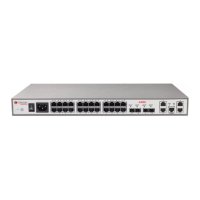A10E/A28E/A28F Configuration Guide
MEP on any device set running CFM in network is called local MEP; MEP on other devices
in this instance is called Remote Maintenance association End Point (RMEP).
One instance can configure multiple MEP, packets sent by MEP in one instance take identical
S-VLAN TAG and with identical priority and C-VLAN TAG. MEP can receive OAM packets
sent by other MEP in the instance and stop packets with the same level or lower than itself.
Figure 8-4 Network Sketch Map of MEP and MIP
MIP
As shown in Figure 8-4, Maintenance association Intermediate Point (MIP) is inner node of
service instance, automatically created by the A10E/A28E. MIP cannot send CFM packets
actively but can process and answer LinkTrace Message (LTM) and LoopBack Message
(LBM) packets.
MP
MEP and MIP are Maintenance Points (MPs).
8.2.2 Preparing for configurations
Scenario
To develop Ethernet technology application in telecommunication network, Ethernet needs to
realize service level identical to telecommunication transmission network. CFM provides full
OAM tool to solve this problem through telecommunication Ethernet.
CFM provides the below OAM functions:
Fault detection function (CC, Continuity Check)
This function is realized by MEP sends Continuity Check Packet (CCM) periodically,
other MEP in one service instance receives packet to confirm status of RMEP. If the
A10E/A28E faulty or link configuration is incorrect, MEP cannot receive and process
CCM from RMEP. If MEP has not received remote CCM packet in 3.5 CCM intervals,
the link is considered to be fault, system will send fault trap according to alarm priority
configuration.
Fault acknowledgement function (LB, LoopBack)
This function confirms connectivity between two MP by sending LBM from source MEP
and answering LoopBack Reply (LBR) by destination MP. Source MEP sends LBM to
MP for fault acknowledgement, the MP receives LBR and sends a LBR to source MEP,

